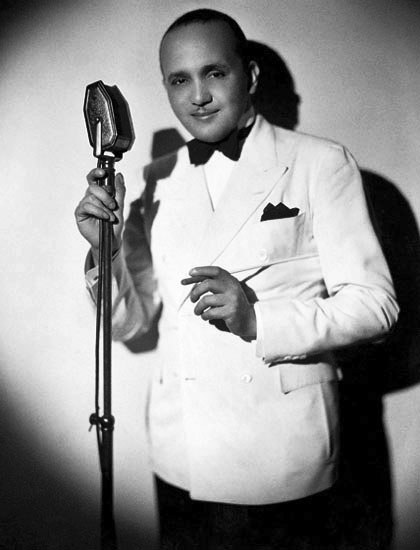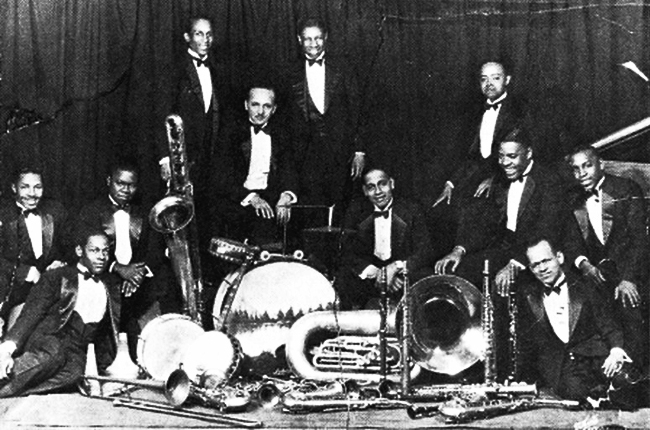Shangai Shuffle
Fletcher Henderson & his Orchestra: Louis Armstrong, Elmer Chambers y Howard Scott (trompeta), Don Redman (saxo alto, clarinete, oboe), Buster Bailey (saxo alto, clarinete), Coleman Hawkins (saxo tenor, clarinete), Charlie Green (trombón), Fletcher Henderson (piano), Charlie Dixon (banyo), Ralph Escudero (tuba) y Kaiser Marshall (batería) (1924).
Después de tres meses en la banda del batería Ollie Powers, a finales de 1924 Louis Armstrong aceptó una invitación del pianista Fletcher Henderson para ir a Nueva York a tocar en su orquesta, la mejor banda de baile afroamericana de la época con arreglos de Don Redman, sustituyendo al trompetista Joe Smith. La ciudad estaba en pleno apogeo artístico y Henderson había conseguido un contrato con su orquesta en el prestigioso Roseland Ballroon. Entonces Armstrong tuvo que cambiar a la trompeta para poder integrarse mejor en la sección de viento.
After three months in drummer Ollie Powers’ band, in late 1924 Louis Armstrong accepted an invitation from pianist Fletcher Henderson to go to New York to play in his orchestra, the top African-American dance band of the time with arrangements by Don Redman, replacing trumpeter Joe Smith. The city was in full artistic bloom and Henderson had landed a contract with his orchestra at the prestigious Roseland Ballroon. Then Armstrong had to switch to trumpet in order to better fit in with the wind section.

Fletcher Henderson
Fuente
Henderson y Redman empezaron a integrar su vocabulario swing en los arreglos, transformando el conjunto en lo que se considera la primera big band de jazz. Los demás miembros del grupo también se vieron influidos de manera gradual por su estilo emotivo, incluido el saxofonista tenor Coleman Hawkins, cuya forma de tocar cambió notablemente, y que más tarde se convirtió en el primer solista de jazz importante con su instrumento. Por lo tanto, Armstrong enseñó a los demás músicos cómo tocar con swing y a su vez él aprendió la nueva dinámica de las orquestas, que estaban divididas en secciones.
Henderson and Redman started to integrate his swinging vocabulary into the arrangements, transforming the ensemble into what is regarded as the first jazz big band. The other members of the group were also gradually influenced by his emotional style, including tenor saxophonist Coleman Hawkins, whose playing changed significantly, and who later became the first major jazz soloist on his instrument. Therefore, Armstrong taught the other musicians how to swing and in turn he learned the new dynamics of the orchestras, which were divided into sections.

Fletcher Henderson & his Orchestra
Detrás de la batería, Fletcher Henderson.
Tercero empezando por la izquierda, Louis Armstrong.
Fuente
Además realizó grabaciones con las principales cantantes de blues femeninas de la época, como Alberta Hunter, Ma Rainey, Trixie Smith y Clara Smith, aunque las que hizo con Bessie Smith fueron las más destacadas. También colaboró en varias grabaciones dirigidas por el vocalista, pianista y compositor Clarence Williams, viejo amigo de King Oliver, y en dos temas coincidió con el otro músico que sobresalía sobre los demás, el saxofonista soprano y clarinetista Sidney Bechet. Sin embargo, Armstrong no se encontraba cómodo en la banda de Henderson: sus compañeros no tenían suficiente disciplina, el líder no le dejaba cantar temiendo que su voz áspera resultara demasiado brusca para el sofisticado público, y cuando Joe Smith volvió le asignaba más solos a él, pues prefería su forma de tocar.
Armstrong also made recordings with the main female blues singers of the time, such as Alberta Hunter, Ma Rainey, Trixie Smith and Clara Smith, although the ones he did with Bessie Smith were the most remarkable. He also collaborated on several recordings directed by vocalist, pianist and songwriter Clarence Williams, a King Oliver’s old friend, and in two cuts he coincided with the other musician who stood out above the rest, soprano saxophonist and clarinetist Sidney Bechet. Nevertheless, Armstrong wasn’t comfortable in Henderson’s band: his teammates didn’t have enough discipline, the leader wouldn’t let him sing fearing that his rough vocalizing would be too rude for the sophisticated audience, and when Joe Smith came back he assigned more solos to him, as he preferred his way of playing.

Bessie Smith
Fuente
Translated with the help of DeepL
https://www.youtube.com/watch?v=pCCyE3e_39k
Fuente

Copenhagen
Fletcher Henderson & his Orchestra: Louis Armstrong, Elmer Chambers y Howard Scott (trompeta), Don Redman (saxo alto, clarinete, oboe), Buster Bailey (saxo alto, clarinete), Coleman Hawkins (saxo tenor, clarinete), Charlie Green (trombón), Fletcher Henderson (piano), Charlie Dixon (banyo), Ralph Escudero (tuba) y Kaiser Marshall (batería) (1924).

Fuente
https://www.youtube.com/watch?v=QSDWTH1rc2w
Fuente

The Meanest Kind Of Blues
Fletcher Henderson & his Orchestra: Louis Armstrong, Elmer Chambers y Howard Scott (trompeta), Don Redman (saxo alto, clarinete, oboe), Buster Bailey (saxo alto, clarinete), Coleman Hawkins (saxo tenor, clarinete), Charlie Green (trombón), Fletcher Henderson (piano), Charlie Dixon (banyo), Ralph Escudero (tuba) y Kaiser Marshall (batería) (1924).
https://www.youtube.com/watch?v=VRHmz_dt8rA
Fuente

Mandy Make Up Your Mind
Fletcher Henderson & his Orchestra: Louis Armstrong, Elmer Chambers y Howard Scott (trompeta), Don Redman (saxo alto, clarinete, oboe), Buster Bailey (saxo alto, clarinete), Coleman Hawkins (saxo tenor, clarinete), Charlie Green (trombón), Fletcher Henderson (piano), Charlie Dixon (banyo), Ralph Escudero (tuba) y Kaiser Marshall (batería) (1924).
https://www.youtube.com/watch?v=VrNElmh1nVo
Fuente

Everybody Loves My Baby
Fletcher Henderson & his Orchestra: Louis Armstrong (trompeta solista), Elmer Chambers y Howard Scott (trompeta), Don Redman (saxo alto, clarinete, oboe), Buster Bailey (saxo alto, clarinete), Coleman Hawkins (saxo tenor, clarinete), Charlie Green (trombón), Fletcher Henderson (piano), Charlie Dixon (banyo), Ralph Escudero (tuba) y Kaiser Marshall (batería) (1924).
https://www.youtube.com/watch?v=BqRERsE_1gs
Fuente

Sugar Foot Stomp
Fletcher Henderson & his Orchestra: Louis Armstrong (corneta), Elmer Chambers y Howard Scott (trompeta), Don Redman (saxo alto, clarinete, oboe), Buster Bailey (saxo alto, clarinete), Coleman Hawkins (saxo tenor, clarinete), Charlie Green (trombón), Fletcher Henderson (piano), Charlie Dixon (banyo), Ralph Escudero (tuba) y Kaiser Marshall (batería) (1924).
https://www.youtube.com/watch?v=hjEiyhESlh4
Fuente










